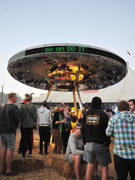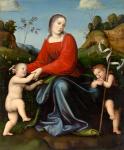
Les Immatériaux: experiments in art and philosophy
A public lecture by Ashley Woodward (Lecturer in Philosophy, University of Dundee) | 28th July 2016
Les Immatériaux (‘The Immaterials’), was a major exhibition held at the Georges Pompidou Centre, Paris, in 1985. It’s principal director was the philosopher Jean-François Lyotard. After several decades of little interest, this exhibition is increasingly becoming recognized as a landmark exhibition of the twentieth century, a recognition marked by a number of commemorative events in France, England, and Germany over the last several years to mark its 30th anniversary. The exhibition collected a wide array of ‘new materials,’ including artefacts developed with new technologies, artworks made with such technologies, and the new technologies themselves. As such, it is becoming recognised as one of the first significant exhibitions of ‘new media’ art.
It included robots, computers, artificial skin, the world’s first showing of a holographic movie, a photocopier, video, film, slides, photographs, a machine which measures the rate of plant growth, a computer which generates poems, and a Japanese sleeping cell, among other things. It put on display the sciences which made new technologies and materials possible: rugosymmetric reproduction, electromicroscopy, spectography, holography, Doppler effects, Fourier series, astrophysics, genetics, and statistics.Alongside the latest technologies and arts deploying them were painted canvases, writings of the literary avant-garde, and architectural designs, representative of abstract, minimal, and conceptual artistic modernisms. Artists, writers, and architects collected included Marcel Duchamp, Yves Klein, Giovanni Anselmo, Thierry Kuntzel, Kasimir Malevitch, Samuel Beckett, Antonin Artaud, Marcel Proust, Maurice Blanchot, Henri Michaux, Octavio Paz, Emile Zola, Stéphane Mallarmé, Heinrich von Kleist, Joseph Kosuth, Georges Seurat, Giacomo Balla, Robert and Sonia Delaunay, Larry Bell, Dan Graham, Jorge Luis Borgès, Piero Manzoni, Peter Eisenman, François Rabelais, Lewis Carroll, Andy Warhol, Raoul Haussmann, Frank Lloyd Wright, and Jacques Monory, to name some of the more well known.
This combination of art, science, and technology reflected Lyotard’s conviction that the disorienting effects and crisis of meaning that science and technology have instituted in the contemporary world have been addressed by parallel explorations in the arts.The exhibition also developed innovative means of design and display, including the choice between several aleatory pathways, and organisation according to ‘sound-zones’ rather than visual markers, making it of interest from a curatorial perspective. As an art and cultural exhibition co-curated by a philosopher, Les Immatériaux constitutes a fascinating case study in the bringing-together of art and philosophy.
This public lecture draws on research undertaken in the archives of the Pompidou Centre and the Lyotard Archive at the Bibliotheque Jacques Doucet, and seeks to imaginatively reconstruct, with the aid of the sounds, images, and texts made available, some of the key aspects of the exhibition, as well as to reveal the philosophical framework which supported this artistic event.
Date: Thursday 28 July, 5.00pm
Venue: Arts Hub Seminar Room, Victorian College of the Arts, St Kilda Road campus, (Ground floor of the Arts hub building near the VCA cafe.)
Attendance free. All welcome. (No need to RSVP.)
Ashley Woodward is a Lecturer in Philosophy at the University of Dundee, and previously taught at the Centre for Ideas at the Victorian College of the Arts. The material presented in this lecture straddles his most recent book Lyotard and the Inhuman Condition: Reflections on Nihilism, Information, and Art (Edinburgh UP, 2016), and the one on which he is currently working,Lyotard’s Philosophy of Art.




